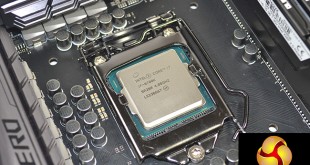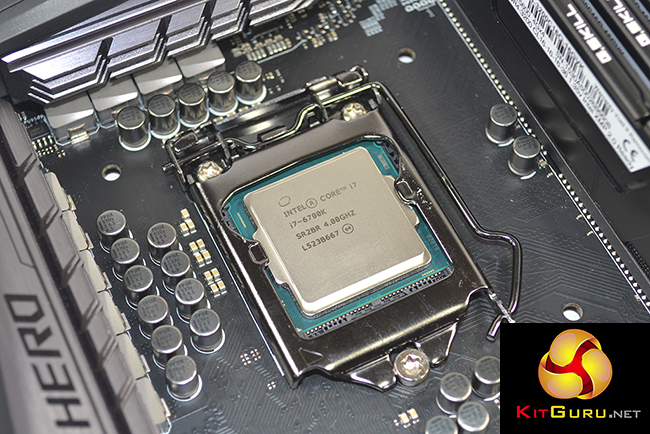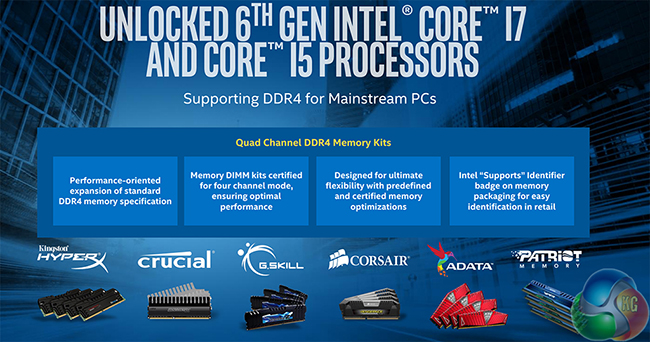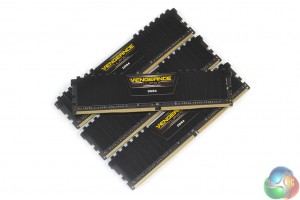
While Intel's High-End Desktop (HEDT) CPUs are fast and fun, it's on the mainstream platform where the chip manufacturing company really shifts volumes to gamers and DIY enthusiasts. Multiplier-unlocked Core i5 and i7 variants of the latest mainstream micro-architecture are the popularity champions on an annual basis; an affordable platform with good enough gaming and general performance from the CPUs translates into a recipe for success. Intel's latest-and-greatest in desktop CPU technology – Skylake – aims to continue that trend, but this time with a platform that is designed to drive the market forward.
Given that Broadwell was so late and, quite frankly, unpopular on the DIY builder scene, let's compare specifically to the Haswell-based predecessors (which includes Devil's Canyon chips). Skylake offers a process node shrinkage from 22nm to 14nm and sprinkles a new architecture into the pudding. The multiplier-unlocked i5 and i7 Skylake CPUs are still largely similar to their Haswell predecessors, however there should be an IPC improvement if Intel has crunched the numbers correctly.
Intel hit somewhat of a recent sweet spot with last year's Devil's Canyon CPUs. High out-of-the-box clock speeds and consistent overclocking gains, tied in with a feature-healthy platform, made up for the relative disappointment that many people had with the initial hot and hard-work Haswell CPUs. Why is that important to Skylake? Because Intel has applied the same logic to its processor launch party.
But there's a lot more to the current situation than just the newly-released CPUs. Windows 10 has been met with open arms and there's also the promise of better utilisation of CPU horsepower with DirectX 12 once the first few games using the new API trickle to market this fall. SSD cost-per-GB ratios are lower than ever before and the same can be said for DDR4, which is now as closely priced to DDR3 as it has been since last year's inception of the memory technology.
Those factors are critical in driving the keenness of many DIY system builders to upgrade their 3+ year-old platform to something more in line with today's requirements. And that's where Intel is trying to cash-in with Skylake. But to reap the rewards of eager builders, performance has to be enough to tempt users away from their ageing, but possibly still satisfactory, platform.
As a testament to the company's gaming focus, or so Intel suggests, the Skylake launch party consists of a pair of gamers' favourite SKUs. The supporting cast of desktop and high-performance laptop chips are expected to follow in the coming months.
Starting with the flagship Core i7-6700K, Intel dishes out a base frequency of 4.0GHz on all four hyper-threading cores with a maximum boost clock speed of 4.2GHz. That's the same base speed but a 200MHz boost deficit when comparing to the Devil's Canyon 4790K. There's the 8MB of cache that has become commonplace for Intel's mainstream unlocked Core i7 SKUs, and the chip commands a 91W TDP.
Switching focus to the Core i5-6600K, the comparison to last year's Devil's Canyon i5 becomes a lot closer. Base frequency is rated at 3.5GHz across all four cores with a maximum turbo speed of 3.9GHz. Factor in the 6MB of cache and the CPU's three main characteristics are identical to those for the i5-4690K.
With 91W TDPs, the chips' power consumption numbers are up 3W over the Devil's Canyon comparisons even though the process node has been switched to 14nm transistors and maximum clock speed is down by 200MHz for the i7. We asked Intel why this was and the somewhat hesitant indication was that the higher-performance on-chip GPU commands more power.
Dual-channel memory is supported, but this time in DDR3L and DDR4 types. More on that later. There's still the same set of sixteen PCIe 3.0 lanes built into the CPU. Skylake processors use an entirely new LGA 1151 socket, making them incompatible with previous generation motherboards. We will explain Intel's mindset on the constant demand for new sockets on the next page.
Retail pricing is almost identical to the Haswell and Devil's Canyon unlocked i5 and i7 SKUs. Expect the i5-6600K to sell for around £190-210 and the i7-6700K for around £290-320.
One of the biggest advancements brought to the table by Skylake is the introduction of DDR4 memory support to the mainstream platforms. Since August 2014, desktop-grade DDR4 has only been useful to consumers who invested in the more expensive X99-based HEDT platform. With the new memory technology being introduced to mainstream desktop platforms, the surge in demand should help to drive prices southwards.
In short, DDR4 has significantly greater operating frequencies than DDR3 but with a penalty of higher latency. The 288-pin DIMMs operate at a lower voltage than is standard for DDR3 (1.20V vs. 1.50V) and support higher capacity chips, such as the 16GB sticks currently available.
All of the major memory vendors have DDR4 kits available for Skylake's launch. Corsair and G.Skill, for example, have 3200MHz 16GB (4x4GB) kits available, spelling some of the highest-speed sets of memory that we have seen on general sale to date.
Perhaps to ease the upgrade cost to users jumping from an older platform, Skylake CPUs retain support for DDR3 memory in its low voltage – 1.35V – form. Intel and motherboard vendors are keen to push consumers towards DDR4 memory, but we have seen talk of some Z170 motherboards supporting DDR3. We haven't yet had a chance to examine DDR3L memory support for Skylake, but we are told that the 1.35V ceiling is pretty much fixed, so the chosen memory sticks must be able to operate at the lower-than-standard level.
This reminds me of the time when we were all told that 1.65V DDR3 would damage Sandy Bridge processors and 1.50V kits should be purchased. Nothing came of that, and 1.65V DDR3 memory proceeded to function correctly with Sandy Bridge CPUs, so it will be interesting for us to take a closer examination of Skylake's DDR3 support in a future article.
Without hesitation, let's take a closer look at the Skylake processors and the platform features.
Features (Core i7-6700K):
- 4.0GHz base frequency (up to 4.2GHz turbo frequency).
- Unlocked core ratio multiplier.
- Full range of BCLK tuning with 1MHz granularity.
- 4 cores, 8 threads.
- 8MB Intel Smart Cache.
- Dual-channel DDR4-2133MHz and DDR3L-1600MHz native memory support.
- 16 PCIe 3.0 lanes.
- Intel HD 530 GPU (1150MHz).
- 91W TDP.
- LGA 1151 socket.
- $350 recommended customer pricing.
Features (Core i5-6600K):
- 3.5GHz base frequency (up to 3.9GHz turbo frequency).
- Unlocked core ratio multiplier.
- Full range of BCLK tuning with 1MHz granularity.
- 4 cores, 4 threads.
- 6MB Intel Smart Cache.
- Dual-channel DDR4-2133MHz and DDR3L-1600MHz native memory support.
- 16 PCIe 3.0 lanes.
- Intel HD 530 GPU.
- 91W TDP.
- LGA 1151 socket.
- $243 recommended customer pricing.
 KitGuru KitGuru.net – Tech News | Hardware News | Hardware Reviews | IOS | Mobile | Gaming | Graphics Cards
KitGuru KitGuru.net – Tech News | Hardware News | Hardware Reviews | IOS | Mobile | Gaming | Graphics Cards








Like the review but leaves me wondering what’s point in upgrading
1.4 volts is too much .. 1.35 is at most what I would consider 24×7 safe with folding for years on end.
Great review, love the OC comparison to HW-E, the only site has done this so far.
If you’re folding 24/7, then you are probably right that 1.4V is a bit too much as it likely to hinder your CPU lifespan. But for most users who are not hammering the CPU 24/7, all of the signs in our testing and the discussions that we have had suggest that 1.4V is indeed fine.
Obviously we can’t certify that with just a handful of chips and a testing period spanning weeks not years. But temperature levels are typically a good indicator of what is safe and what isn’t.
Really there is no point to upgrade if you have a 4XXX i7, I hope AMD will get their shit together and release something really competitive because intel is dominating now and they doesn’t seem to care enough to push for better performance.
“With a very small pricing difference between an i7-6700K system and one based around the i7-5820K…”
From what I’ve seen so far the 5820k is going to cost you a hundred dollars more, so I guess there’s some difference of opinion on what constitutes a “small” pricing difference….
Well if you’re making a long term purchase (3yrs+) then a 5820 with 6 slightly slower cores will be a far better purchase than a 6700K, those two extra cores will start to pay dividends further down the line.
5820k £293 https://www.overclockers.co.uk/showproduct.php?prodid=CP-546-IN&groupid=701&catid=6&subcat=1672
6700k £299 https://www.overclockers.co.uk/showproduct.php?prodid=CP-582-IN&groupid=701&catid=6&subcat=3069
Yay, sub 10% X86 performance gains. And here we thought Skylake was going to have significant gains. Maybe Kaby Lake or Cannon lake with be significant over Haswell. But not holding my breath.
I don.t think people on buget like me should change from ivy brige (i5 3570k or i7 3770k) to this one …
Can you explain why?
zen cpu’s are going to be about 50 per cent faster per core than fx cpu’s so yeah intel will still have a pretty good speed advantage
6700k £263.99 – http://www.ebuyer.com/718338-intel-core-i7-6700k-4ghz-socket-1151-8mb-l3-cache-retail-boxed-processor-bx80662i76700k
5820k £306 – http://www.ebuyer.com/661535-intel-core-i7-5820k-3-30ghz-socket-2011v3-15mb-cache-retail-boxed-processor-bx80648i75820k
So about $100 for the americans, 40quid for us.
I’m now totally and utterly torn. I want to upgrade my i7 920 @ 4Ghz, but I just don’t have a clue to which. They are far too close, and with no real DX12 benches to go by, it’s difficult to say if those extra cores will come into play. There is every chance they will of course, but at this point, its too damn close.
Umm the AMD Zen chips are 40 percent in IPC over Excavator and without the Excavator IPC enhancements its on par with Haswell
Can’t wait for the i7 6820k !
not just the extra cores, but the extra cache and extra pcie lanes all add extra value and potential performance gains over these quad core chips. X99, like X79 and X58 before it, has much longer legs than Z170 and the lowest (I7-5820K) chip is within reach (~$50) of the I7-6700K.
of course they will come into play. during testing of the new OS they’ve already demonstrated significant improvement in multi core utilization/optimization. it’s only going to get better as software developers get working with it.
I totally hate the lack of older CPU’s (2600K or 3770K etc) in this review, but kudos for including oc’d Skylake results.
Single Threaded performance is still king. 6 cores won’t be mainstream for years.
You believe marketing more than you should.
lol@folding. people still do that?!
Its not marketing WFFCTech and RedGamingTech theorized it would be but it definitely isn’t going to be a slouch.
Roflmao!
What’s the incentive for “significant gains”? Without competition, there is no need. This isn’t about making us upgrade; they couldn’t care less if we postponed forever, all Intel cares about is that we choose them after our hiatus. If we go to another brand (whether it be AMD, or going the ARM route since most users aren’t gamers), then only would Intel up the bar to make any remaining stay loyal to them.
Haswell-E doesn’t have iGPU, you’re thinking of Haswell/Devil’s Canyon.
either way i expect you’re gonna be happy with a chipset upgrade 🙂
Yup. Though, the TDP and efficiency of the chips wouldn’t be lacking because of lack of competition would it? It’s because they are concentrating on iGPU performance I guess. Probably could squeeze more efficiency or computation/watt if they felt like it!
Me too. We specifically went out and bought a 2600K to act as a comparison because we didn’t have one at hand. But the time period given for testing the new hardware was really tight so we chose to include a full set of OC results on the chips we tested, rather data from older CPUs. This allows people to decide whether they want to wait for large scale availability to buy Skylake or whether Haswell-E (or a DC bargain, if they can get it) is better for them.
We’ll be including data from the older chips in the upcoming articles we have planned.
LMAO WCCFTECH?
Luke, if you get a chance, would you comment on the availability of HDMI 2.0 and HDCP 2.2 on these MB’s. It seems Gigabyte holds the most promise, but I haven’t been able to find any supporting documentation in that regard.
Oh, I hear it’s because of the serial nature of general purpose processors. They can’t make the integer/floating point units and more numerous per core, because the Instruction Scheduler couldn’t keep the pipeline full because of indirect and conditional branches. Maybe if the Scheduler could do some math itself and predict further..
1.4 volts to achieve 4.7GHz is an indication of really poor ASIC quality. I would wait for Skylake-E.
Why would a good cause go out of style?
Thing is, the single threaded performance is literally only a little better than Haswell.. Nearly all reviews show that, and some like OC3D say the Skylake chips are awesome while bashing the 5820k.. No sense at all.
Not true anymore. A vast majority of software and games use two or more threads now.
1.4V is fine for daily use on liquid cooled systems as temps are always kept in check. I’ve been running my 3930K @ 4.5Ghz @ 1.41V liquid cooled daily for almost 5 years and have had no issues whatsoever.
Don’t hold your breath. No miracles are going to arrive with Skylake-E. For noticeable improvements to TDPs and OC potential, look further in the future to Cannonlake and beyond.
…too bad they didn’t provide the idle and load temps for HW and HW-E…I noticed immediately how those figures were conveniently missing…lol What I can tell you is that I recently switched from a 4690K to a 6600K system build. Using the exact same cooler and TIM, the differences in temps at idle and under load are HUGE. 4690K @ idle = 36C 6600K @ idle = 21C. 4690K @ load (Prime95; Small TFTs bench) = 80C 6600K @ load (Prime95; Small TFTs bench) = 60C. The 6600K ran 20C cooler – that is no joke, and was reason enough for me to upgrade!
Thanks to further delays with 10nm FinFET the HEDT platform will now be two generations and a process node behind. I don’t even see the point of Skylake-E anymore if 4/6/8-core Cannonlake parts are going to be released in the same year.
“stock-clocked Skylake Core i7-6700K”. I don’t see stock cooler.
Is 1.42Vcore voltage, too high for a spiked voltage on the 6700K?
That’s awesome! Thanks for sharing that data. I’ll set up i7 6700K soon and update on my temps here.
What is folding?
or not cause by the time the 6 cores are really usefull vs , the higher clock frequency of a 6700 you’re 5820 will be crap anyway (and the 6700 too)
right but i upgraded anyway not for the small gains but i had a 3770k so now i can have m2 ssd as well as sli which i couldn’t before on my previous mb as well as many usb 3.1 ports etc etc
Cool
http://folding.stanford.edu/ It’s a project doing research into various diseases. Really cool thing. Not sure why Jimmy would be laughing at trying to cure things like cancer and Parkinson’s and Alzheimer’s. Even as of years ago tons of published research had already used Folding @ Home as part of their research.
yup, either buy 6600k or skip the 6700k to buy 6800k. Then it makes sense.
I run 4690k at 1.4v for months.
We apply very near maximum settings in Grand Theft Auto V and a 1920×1080 resolution to push today’s hardware. Our data was recorded using the built-in benchmark.